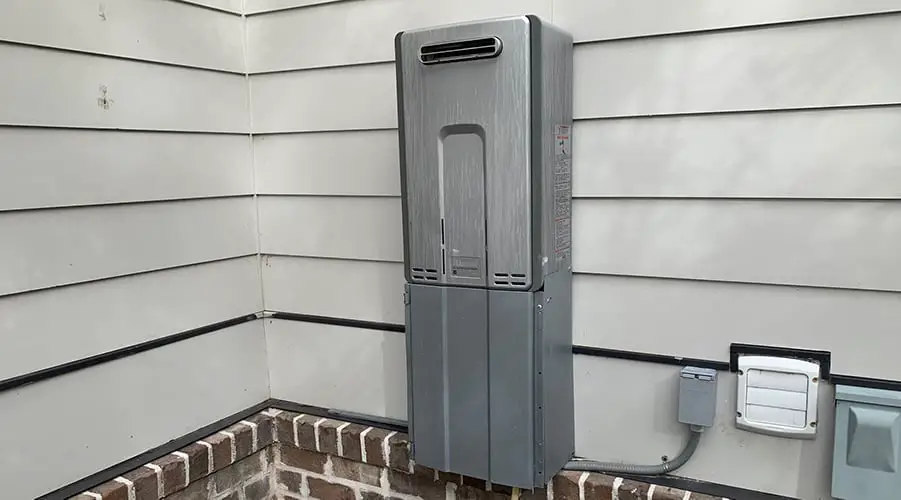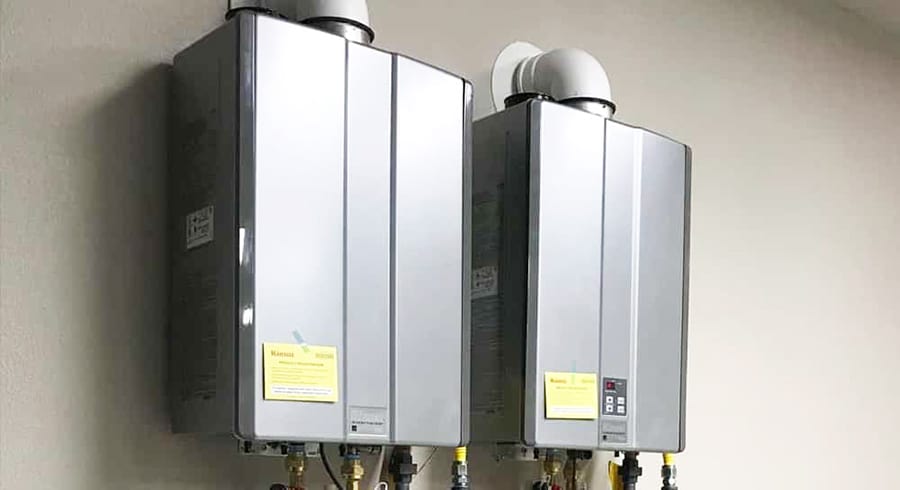
Whenever you hear mention of tankless water heaters, you’ll also hear they provide on-demand hot water. If your tank water heater struggles to keep up with your hot water demands, going tankless sounds like the perfect solution. So let’s discuss whether tankless water heaters run out of hot water?
Tankless water heaters provide hot water on-demand; however, tankless water heaters can appear to run out of hot water in times of peak demand. When demand is high from multiple fixtures, the unit may not heat water fast enough to meet demand.
So, in theory, a tankless water heater can deliver an endless supply of hot water on demand, but you need to understand there are limitations. In this article, we’ll explain the basics of how a tankless water heater works. We’ll then discuss some of the reasons it might seem to have run out of hot water.
How Does a Tankless Water Heater Work?
A tankless water heater, unlike the traditional tank systems, doesn’t store hot water.
Instead, it heats the water whenever you turn on a hot water supply on your faucet. Natural gas and propane tankless water heaters produce hot water on demand by using powerful gas burners. Electric tankless water heaters use electric heating elements to heat water quickly.
Tankless water heaters are often installed outside; however, indoor tankless water heaters are also available. The only difference between indoor and outdoor tankless water heaters is how they are vented.
So, when you open your hot water faucet:
- The cold water comes into your tankless unit and passes through to a heat exchanger.
- A sensor detects this flow of water and fires up the burners or heating elements.
- The heat exchanger transfers the heat produced by the burners or elements to the water.
- Once at your set temperature, the hot water goes straight to the faucet.
- When you turn off the faucet, the heating process stops.
So, on-demand heating wastes less energy because you don’t have to keep a water tank at a set temperature. A tanked system continually uses energy to heat the stored water, even if there’s no immediate demand for it.
It takes a lot of energy for a tankless system to heat the water to meet demand quickly. However, it’s still more efficient than continually heating stored water.
Based on figures from energy.gov, if you use up to 41 gallons (155ltr) of hot water a day, a tankless unit is 24%-34% more energy-efficient than a tank system. For households that use 86 gallons (325ltr) a day, the efficiency improvement is about 8%-14%.
It sounds simple, yet things can go wrong and result in a lack of hot water. So, let’s investigate why that might happen with a tankless system.
How Tankless Water Heaters Run Out of Hot Water

Demand Can Overwhelm a Tankless Water Heater
One of the primary reasons your tankless system might stop producing hot water is because it’s being overwhelmed by the demand.
This can happen if there are several hot water appliances in use at the same time. For example, if you run a bath, a clothes washer, a dishwasher, and a shower at once.
If the demand exceeds the tankless system’s capacity, you’ll end up with some appliances receiving hot water and some not. Or, none of the appliances will receive hot water. Worse still, the tankless system may shut itself down because it’s overloaded.
Calculating Your Peak Hot Water Demand
This is why you need to ensure that the tankless water heater you buy can meet your hot water requirements.
To work this out, you have to calculate the gallons per minute of hot water your household uses at peak times.
You do this by working out what appliances you use simultaneously and the hot water flow rate when they’re in use. This will give you your peak gallons per minute or GPM.
For example, if your peak demand is two showers, each running at 2GPM and one faucet at 1GPM, your total peak usage is 5GPM.
Next, you work out how your incoming water temperature has to increase to reach your desired temperature. This is the temperature rise.
You’ll need to check your incoming water temperature with your water source. If you’re not sure about this, groundwater temperature maps can give you a general guide.
Say your average groundwater temperature is 47°F (8.3°C). You want your hot water at 104°F (40°C). That means you have a temperature rise of 57°F (a 31.7°C rise).
So, you need to choose a tankless system that can increase the incoming cold water temperature by 57°F (or 31.7°C) when the water flows at 5GPM.
For example, you could choose a Rinnai RU160iN Sensei system. That gives a flow rate of about 5.6GPM for a temperature rise of 57°F (or 31.7°C).
The next model, the Rinnai RU130iN Sensei, is slightly cheaper. But it only gives a flow rate of 4.6GPM at this temperature rise. So you’ll pay less, but you’ll end up very frustrated because you may not get enough hot water during peak times.
This would give the impression that you’ve run out of hot water.
You May Need Two or More Tankless Water Heaters

If you have a large home where hot water has to travel a long distance, have a large family, or routinely have houseguests, you’ll likely need multiple tankless water heaters to keep up with hot water demands.
We routinely see kitchens and laundry rooms sharing one tankless unit while the bathrooms are sharing another unit. Even with the largest tankless water heater available, large families can still exceed the tankless water heater’s capacity to produce hot water.
Having tankless water heater systems is helpful if you have any of the following:
- A large house with kitchen and bathrooms on opposite ends of the house where hot water has a long distance to travel. Often, tankless water heaters can take over 2 minutes for hot water to reach you. This is often because the tankless water heater is located a long way from the appliance or fixture.
- Have a large family or routinely have houseguests that shower at the same time. This is especially amplified if you also run a dishwasher or wash clothes and shower simultaneously.
If you don’t want to install two tankless water heaters, you may consider having a recirculation pump with a gas or electric storage tank. See our article Tankless Water Heater Setups that Require Expansion Tanks.
The Water Flow Rate Is Too Slow
A slow flow rate arises when you open a faucet slightly. If the water isn’t flowing fast enough, your tankless system’s heating process won’t start.
Each tankless water heater has a minimum flow rate that it needs for the combustion process to begin. Using the Rinnai gas models as an example, they need a minimum flow rate of 0.4-0.6GPM to ignite the burner.
If you don’t open your faucet enough to give that flow rate through the tankless unit, the burner won’t ignite. So, the water will run cold, as if you’ve run out of hot water.
The Rinnai gas models also have a minimum flow rate of 0.26GPM to keep the burner running once ignited.
So, if you turn your faucet on full, you’ll get hot water. But if you turn it right down, your water will turn cold if the reduced flow rate is below 0.26GPM. So, it’ll seem like you’ve run out of hot water.
The Build-Up of Limescale Restricts the Flow
Limescale build-up is another common reason why your tankless water heater might appear to have run out of hot water.
Limescale build-up results from the presence of calcium and magnesium in your groundwater.
The water hardness depends on its calcium carbonate content measured in milligrams per liter. So, soft water contains 0-60mg/L of calcium carbonate, while very hard water contains more than 180mg/L.
The problem with hard water is that when heated, it leaves behind calcium carbonate deposits. These can accumulate in pipes and water appliances.
If these accumulations are present in your pipes, they can reduce the water flow rate. The rate might fall below the minimums that your tankless unit needs to ignite or maintain the burners. As you’ve seen above, that might mean you won’t get hot water.
If the heat exchanger within your unit becomes clogged with scale deposits, it’ll take longer for the heat to transfer from the burner to the water. It may even mean that the system can’t get the water to your desired temperature. Again, the appearance is that you’ve run out of hot water.
Your Tankless Water Heater Has Errored
Another reason your tankless water heater may stop producing hot water is an error code. If your water heater has errored, it will usually have an audible alarm.
If your tankless water heater is beeping, check the error code on the digital display. You’ll likely need to look up the error code in your owner’s manual. Most error codes can be cleared by resetting the tankless water heater. However, there are exceptions:
- There is an ignition failure caused by a lack of gas flow to the unit, a power failure, or an ignition failure.
- Your tankless water heater needs flushing service. Yes, tankless water heaters do need to be flushed. This is often called descaling your water heater.
- There is a burner failure inside the tankless water heater.
- The tankless water heater thermostat may have failed.
These failures, and others like these, will often shut your tankless water heater down to protect the system. You’ll often need to have the unit worked on by a plumber to get it working again.
Conclusion
So, several reasons why a tankless water heater might appear to have run out of hot water. We’ve covered some common ones in this article.
But, as you’ve seen, it’s not that the tankless water heater has run out of hot water. It likely just can’t keep up with demand.
You can avoid the problems discussed by choosing the right unit and then using and maintaining it correctly.







